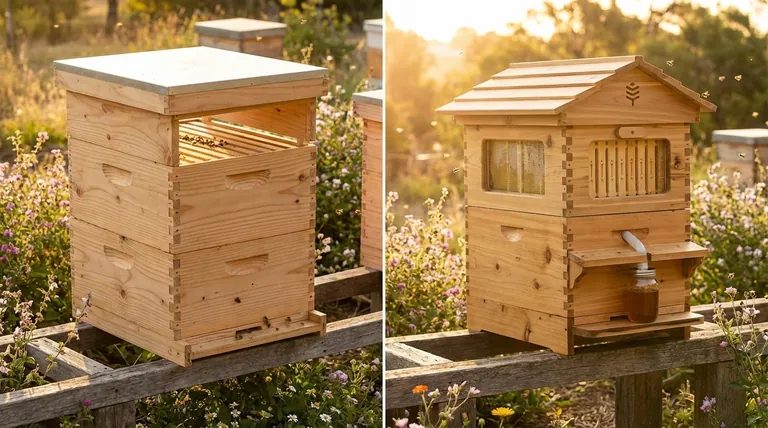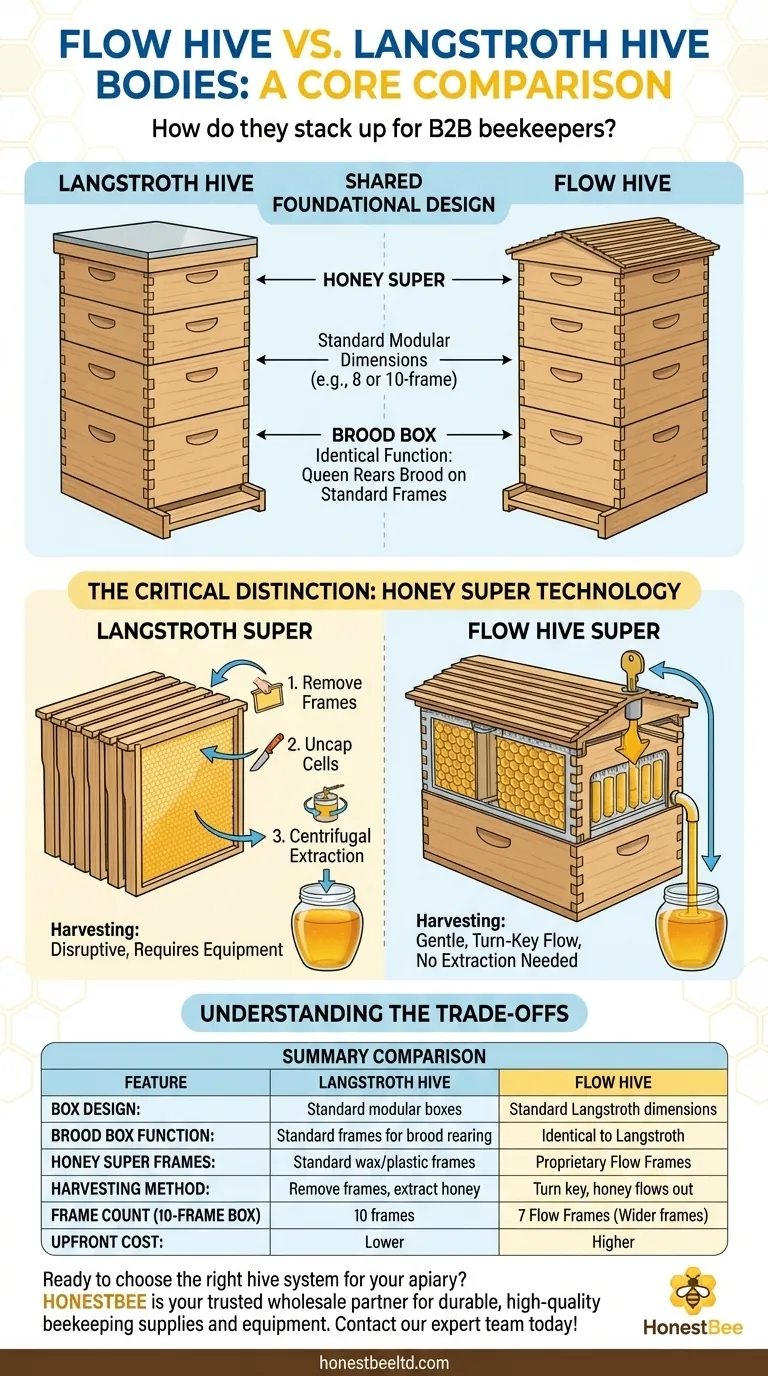At their core, the hive bodies of a Flow Hive and a standard Langstroth hive are built on the same foundational design. A Flow Hive is essentially a modified Langstroth system, designed intentionally to share the same basic dimensions for the boxes themselves. The critical difference lies not in the wooden boxes, but in the specialized frames used within the honey super for harvesting.
The most important takeaway is this: A Flow Hive is a specialized type of Langstroth hive. The brood box is functionally identical, but the honey super is engineered with proprietary "Flow Frames" that change the honey harvesting process entirely.

Foundational Design: A Shared Heritage
Both hive systems are based on the revolutionary modular design invented by L.L. Langstroth. This shared DNA dictates their fundamental structure and operation.
The Modular, Vertical System
Both hives consist of a stack of modular boxes. This includes a bottom board with an entrance, a lower brood box for the queen to lay eggs and raise young, and one or more upper boxes called honey supers for honey storage.
A roof sits on top to protect the colony from the elements. While Flow Hives often feature a decorative gabled roof, and Langstroth hives a simpler flat roof, this is a cosmetic difference.
Standardized Dimensions
The designers of the Flow Hive made a critical decision to base their product on standard Langstroth dimensions (typically 8-frame or 10-frame sizes). This ensures a degree of cross-compatibility between the two systems.
This means you can place a Flow Hive super on top of a standard Langstroth brood box, or vice versa. The boxes themselves will fit together correctly.
The Critical Distinction: The Honey Super and Its Frames
While the boxes are compatible, the technology inside the honey supers is what truly separates the two systems.
The Langstroth Super
A standard Langstroth honey super is filled with simple wooden or plastic frames. Beekeepers provide a foundation sheet of wax or plastic, and the bees build out their own complete wax honeycomb on it.
To harvest honey, these frames must be physically removed from the hive, the wax cappings must be cut off, and the honey must be spun out using a centrifugal extractor.
The Flow Hive Super
A Flow Hive super contains proprietary Flow Frames. These are complex, pre-formed plastic honeycomb cells that are already fully drawn.
The bees fill these cells with honey and cap them with wax as usual. To harvest, a tool is inserted and turned, which splits the cells vertically inside the frame, creating channels for the honey to flow down and out of the hive through a tube, all without opening the hive.
A Note on the Brood Box
It is crucial to understand that the brood box in a Flow Hive functions identically to a Langstroth. It uses standard Langstroth-style frames where bees build natural comb for the queen to lay eggs. All routine hive management, such as checking for pests, disease, and queen health, requires opening this brood box in both systems.
Understanding the Trade-offs
The promise of compatibility and convenience comes with important practical considerations.
The Myth of Perfect Interchangeability
While the boxes fit, the frames do not have a 1:1 ratio. Flow Frames are significantly wider than standard Langstroth frames.
Because of this, a 10-frame Langstroth-sized super will only hold 7 Flow Frames. This impacts the total volume of honey that can be stored in a single super.
Harvesting Method vs. Hive Management
The Flow Hive drastically simplifies the honey harvesting process, making it less disruptive and eliminating the need for expensive extraction equipment.
However, all other aspects of beekeeping—inspections, pest management, feeding, and swarm prevention—are exactly the same and require opening the hive. The Flow Hive is not a "no-management" system.
Upfront Cost vs. Downstream Investment
A complete Flow Hive carries a significantly higher initial purchase price due to the complex technology in the Flow Frames. A Langstroth hive is much cheaper upfront but requires a later investment in extraction equipment if you scale your operation.
Making the Right Choice for Your Goal
Your decision should be based on your personal beekeeping philosophy, budget, and goals.
- If your primary focus is low cost, tradition, and maximum compatibility: The standard Langstroth hive is the universal industry choice with widely available and affordable components.
- If your primary focus is harvesting convenience for a few hives: The Flow Hive offers an unparalleled, clean, and gentle method for extracting honey with a minimal learning curve.
- If you want a hybrid approach: You can start with a standard Langstroth setup and later add a Flow Super to one of your hives to experience both methods.
Ultimately, choosing between them is about selecting the right tool that best aligns with how you want to interact with your bees.
Summary Table:
| Feature | Langstroth Hive | Flow Hive |
|---|---|---|
| Box Design | Standard modular boxes | Standard Langstroth dimensions |
| Brood Box Function | Standard frames for brood rearing | Identical to Langstroth |
| Honey Super Frames | Standard wax/plastic frames | Proprietary Flow Frames |
| Harvesting Method | Remove frames, extract honey | Turn key, honey flows out |
| Frame Count (10-frame box) | 10 frames | 7 Flow Frames |
| Upfront Cost | Lower | Higher |
Ready to choose the right hive system for your apiary? Whether you're a commercial beekeeper scaling up with traditional Langstroth equipment or a distributor looking to offer innovative solutions like the Flow Hive, HONESTBEE is your trusted wholesale partner. We supply durable, high-quality beekeeping supplies and equipment designed for performance and longevity. Let us help you build a thriving operation. Contact our expert team today to discuss your needs and request a wholesale catalog!
Visual Guide

Related Products
- Honey Flow Garden Bee Hive Flow Hive Best Beehive for Beginners
- Langstroth Bee Hives Bee Keeping Box for Beginners Beekeeping
- Automatic Honey Flow Beehive 4 Frame Mini Hive for Beekeeping
- 7 x Auto Bee Flow Hive Frames Plastic Beekeeping Hive Box Supplies
- HONESTBEE Advanced Ergonomic Stainless Steel Hive Tool for Beekeeping
People Also Ask
- How does honey production differ between Flow Hives and Langstroth hives? Choose the Right System for Your Apiary
- How does the Flow Hive reduce stress on bees during honey extraction? A Guide to Gentle Harvesting
- What are the benefits of a Flow Hive? Revolutionize Your Harvest with Ease and Care
- What are the benefits of the Flow Hive for novice beekeepers? Simplify Honey Harvesting & Reduce Stress
- What makes polyurethane foam environmentally friendly? The Surprising Benefits of a Durable, Inert Material



















